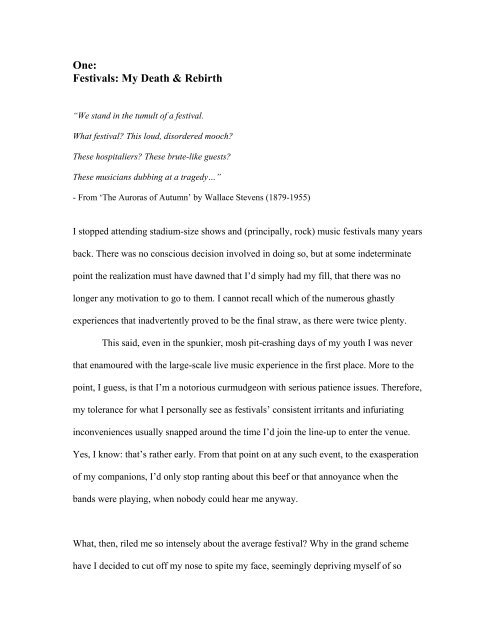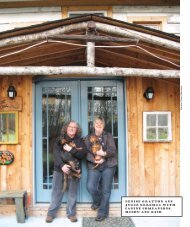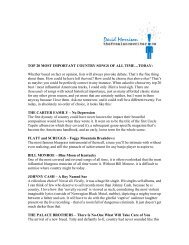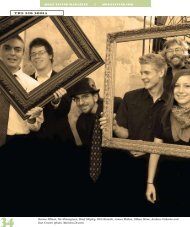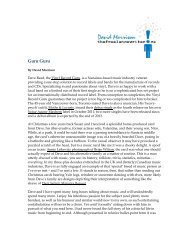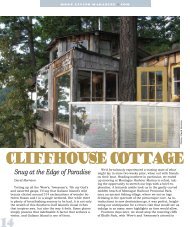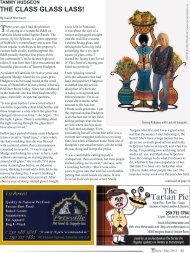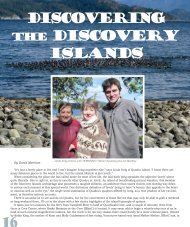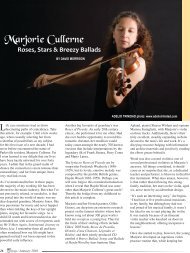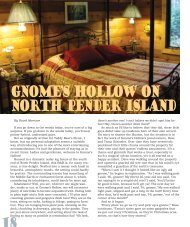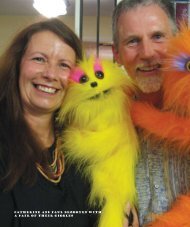Festivals: My Death & Rebirth - David Morrison - The Freelance Writer
Festivals: My Death & Rebirth - David Morrison - The Freelance Writer
Festivals: My Death & Rebirth - David Morrison - The Freelance Writer
- No tags were found...
Create successful ePaper yourself
Turn your PDF publications into a flip-book with our unique Google optimized e-Paper software.
As Berner implies, I feel most of the more musically “enticing” festivalsaccommodate more humans in one place than is reasonable - obviously in order tomaximize profits - but I find being in such enormous gatherings very uncomfortable.<strong>The</strong>re may well be a mild claustrophobic element to this – I’ve not been on a couch for itand do not generally otherwise suffer – but it’s mainly the obstructive lack of ease inaccessing what I want or need that really upsets me. I find it utterly ridiculous that thesheer volume of people I’ve been hemmed in by at festivals has dictated the need to setout from hard fought-for scraps of ground to locate a toilet even before I felt the urge touse one. Such is the time it takes to battle through the unruly hordes to where they’resited. Pre-emptive planning was always the key: “I might, just might need a wee in anhour, so I’d best be on my way this instant.”I’m sure there are health and safety regulations in place concerning at what pointthe capacity of a festival is capped in relation to where it’s held, but I’ve never seen thisin obvious action. <strong>The</strong>re have always been waaaaaaay too many folks at all the eventsI’ve attended, and being compressed to within three breaths of suffocation in the midst ofseveral billion sweaty lunatics never did that much for my general ‘festive’ mood.Additionally, enforced camaraderie aside, shuffling with agonizing slowness aroundfestival sites, my movement governed solely by the flow of amorphous ‘humanity’ I wastrapped among, was also not so often my idea of a great day out. “Hey, everyone! I didn’treally want to be at the cotton candy stand, to be frank. Can we perhaps veer east andshamble as one towards the veggie burger concession? Thanks ever so much!” Hell,exiting festivals in said manner often took several days.
over a bill for a Belgian single-day festival boasting Neil Young, Lou Reed, Nick Cave &<strong>The</strong> Bad Seeds, R.E.M., Joe Jackson, Pixies, Robert Cray and Elvis Costello - all at theirpeak - plus just a couple of ho-hum fillers (singing anagram Tanita Tikaram, anyone?),the urge to say no remained very strong, almost driving me eleven-sixteenths insane. Butresistance is futile when the power of rock commands thee! I’d put up with most anythingyou care to mention to witness that lot live in one day. In fact, I did.Biting the bullet with a curious mix of reluctance and excitement, I handed over aludicrous sum of Flemish francs (or whatever Belgian currency was before the euro madeeverything even more expensive), and hopped on a bus to the Continent. This particularfestival, Werchter Rock, proved to be the anticipated mix of brilliant performances (NickCave altering the course of my life that day); extreme discomfort (oh, that lake of vomit);the very worst of youth gone wild, and the laughably blatant exploitation of a captivemarket. (If I told you the price of the waffles, you’d call the police.)However, very occasionally since those days, though I remained stoically in festivalretirement, I’ve been delightfully surprised to see the trends of festivaldom I so despisedefiantly bucked by apparently like-minded individuals. But then, one such exampleoccurred in July 2007 in Nanaimo - my new hometown of just seven months at the time -with the staging of the first Green Mountain Music Festival.I’d not considered checking out an event like this for so long, but wasmagnetically attracted by certain distinct qualities, ones usually absent from larger scalefestivals. That it was a charity event - all bands playing for free, every cent of profitheaded to the Canadian Cystic Fibrosis Foundation - was obviously an appealing aspect.
And that, despite this, the tickets were a mere ten bucks for twelve hours’ diverse indierock entertainment, was also very impressive. (It’s so perverse that this was one instancewhere I’d have happily paid more, but there is no denying the bargain price helped swaymy wife Susan and I.)It did of course also count that we knew people in a couple of the bands.Additionally, it seemed from all advance publicity - conducted well away frommainstream channels to seemingly urge word-of-mouth promotion - that this wasdefinitely going to be a small grassroots affair. <strong>The</strong> site was apparently a small farm, alsoadding to the appeal.Finally, crucially, there was a pronounced thrill-of-the-new keenness about us inrespect of this festival. We’d been in wide-eyed, full-on exploration and cultural spongemodes since arriving permanently on Vancouver Island from the UK in December 2006,eager to assimilate and find our feet as quickly as possible. Anything that was going on,we wanted to know about it, especially in terms of musical entertainment. We’d leftbehind a city boasting a rich, globally recognized music scene in which I’d been heavilyinvolved in various capacities for nearly twenty years, so I started on finding out whatwas what here as soon as we got off the plane. It may even have been as soon as baggagereclaim.Consequently, we were aware that the island’s summer festival season was lively,and despite all reservations based on past experiences I thought it worth investigating inthe event we were missing out on something truly special. Although naturally still fearingthe worst, <strong>The</strong> Green Mountain Music Festival was the first outdoor event we’d heard of
since arriving that looked fairly closely aligned to our musical tastes. So we took thatplunge and picked up some tickets.In a nutshell, it was an incredible day. So much faith was restored! I’ve alreadyunderlined the excellent value offered by this shebang and how noble its intentions were,but my other fears were also allayed to such an extent that if I could design my ownfestival, the model wouldn’t fall too far short of this one. Believe me, I do not say thislightly!A comfortably sized crowd of just a few hundred made moving around, claiminga bit of land and clearly seeing the bands, a doddle. Personal space was respected. <strong>The</strong>easily identifiable party-heads partied, but behaved themselves, offending no-one. (Ithelped that there seemed to be no obvious Oasis fans present.)<strong>The</strong> bands, mainly new to us, were absolutely on the money. One, No Horses, hassince become one of my favourite bands on this or any other planet.Everything on sale - tasty homemade snacks, mini-doughnuts, candy and otherbits and bobs - was sensibly priced and served by folks who were happy to see you. <strong>The</strong>ywere so cheap and served with such friendliness, in fact, that it was almost unnerving,arousing a but-what’s-the-catch suspicion in one so accustomed to rip-off festival culture!What’s more, there were no line-ups. No tokens. No warm, watery froth. No spillage. Nohassle. No kidding.And God love us, the toilets remained clean and respectably used for the benefitof all present. Even late in the day, aside from the unavoidable, though never
overpowering aromas, the facilities were in as sanitary a condition as I’d imagine couldbe maintained in any situation where a large group of humans are assembled.See, it can be done!Above all - not that festival locations themselves ever particularly irked me - thesite was extraordinary. Hugging the base of Mt. Benson in the lush, rural Jingle Pot area,the flatbed stage was backdropped by a pretty rock outcrop topped with arbutus trees, andthe performers’ view from the stage can have only served to inspire. As we watched thebands in this unexpected comfort, squadrons of dragonflies cruised low and silent overthe farm all day, adding an almost surreal, dreamy dimension to proceedings. It reallywas so very lovely.Yes, this was an off-the-radar event to a great extent, untainted by commercialism, heldon private property and kept deliberately low-key to avoid hassles with the RCMP or anyother potential sources of disruption - but it did serve to illustrate just how good festivalscan be when all the right elements slot nicely together. Some would claim it was not afestival at all, but an oversized party with bands. Regardless, we left musically sated,impressed at the organisation, with some new friends.Most of all, my curiosity was fired as to how things might be done elsewhere, atthe bigger events on Vancouver Island I’d been reading about. I wondered whether thiswould be strictly a one-off or if this really was the way of things in this part of the world?<strong>The</strong>re was no doubt I was encouraged – dazzled, even - by the refreshing GreenMountain experience but, if we were to decide in its wake to attend more like it,regardless of musical theme or overarching genre, might it actually transpire that I’d
discover such levels of civility and all-around pleasantness everywhere? Or had this allbeen just a nice dream and I’d wake up to find myself trampled under a stampede towardswhere Nine Inch Nails were about to let rip?<strong>The</strong> Green Mountain Music Festival served to galvanize us to attend one more festivalthat summer. It may well have been more, but we moved house in August (on theweekend of the Coombs Bluegrass Festival – the one I most fancied), so were financiallystretched with an awful lot going on. <strong>The</strong> one we chose was called – to this day, for noobvious reason – Farmfest ’93. (If you look carefully, the clue’s in the name concerningthe type of location at which it was staged.)From the off, when we heard only its banner and one of the artists booked toappear, it felt as if this event would be in the same groove as Green Mountain, especiallyas it again seemed way off the grid. So far off it, in fact, that finding out anything aboutFarmfest ‘93 was a real grind. Beyond fogged clues popping up on the <strong>My</strong>Space pages ofvarious Victoria and Nanaimo bands presumably booked to appear, there was absolutelyno discernible local publicity.But this is exactly what appealed to us: Farmfest ’93 seemed like anotherdeliberate attempt to remain as underground as could be achieved, an ethic we connectwith, though I did wonder how such a strategy would affect the potential of attracting acrowd to make it worthwhile. After all, there’d surely be a few attendant bills to pay? Butmaybe there was no concern for that? As it happens, Farmfest ’93 turned out to be anentry-by-donation event, so perhaps not. I don’t really know, but what I can tell you is we
Between meeting Eamon and now, everything that’s happened in my life -whether good or bad – clearly seems to have been adding that little extra torque to therubber band of the catapult that eventually shot me over four thousand, seven hundredmiles to Nanaimo to start a new life. I’m not suggesting that Eamon is some kind ofmystical catalyst for it, but in terms of my being chosen to write about the Islands FolkFestival, he simply has to be the logical starting point.You see, when I tell you that Eamon’s aunt, Deb Maike, is the co-founder of theCowichan Folk Guild, the group responsible for staging the Islands Folk Festival, whoseArtistic Director, Robert McCourty, independently approached me with the book idea -Deb having absolutely no knowledge of his advances until later - then you should seewhy I feel even as the grounded individual I am that it goes way beyond coincidence! Imean, of all the gin joints, in all the towns, in all the world. Talk about degrees ofseparation, small world experiments ‘n’ all that! And if you knew everything in betweenmeeting Eamon and Robert’s approach, I’d surely need to whip out the smelling salts!****<strong>The</strong> second Green Mountain Festival, another spectacular day attracting a hundred or somore than the inaugural event, was held on Saturday July 19 th , 2008 – the weekendbefore the 24 th annual Islands Folk Festival at Providence Farm in Duncan. Courtesy ofRobert, Susan and I were bestowed with VIP media passes to attend the latter, andconfidence was high in the wake of another positive festival experience that we could bein for a real treat. Cool: our first “proper” Vancouver Island roots bash!
We first met Robert literally when he was playing acoustic guitar for his splendid andsplendidly named band, <strong>The</strong> Flying Accusations. At the time, he just happened to besurrounded by freakish examples of a vegetable whose name, somewhat misleadingly,originates from the Greek word for “large melon.” As big fans of country and bluegrassflavouredmusic, we stood listening as he and his talented cohorts twanged up a storm. Isay ‘listening,’ as how we could actually see the band over the barrier of boulder-sizedpumpkins is anyone’s guess. But then this was a festival devoted to both standard andmonstrous examples of the good ol’ Cucurbita pepos, held at Nanaimo’s late lamentedShady Mile Farm. (For the horticulturally inclined, incidentally, Mr. Art Carefoot’scolossal pumpkin took the gold award in 2007 - tipping the scales at an insane 1,070.8 lb.Imagine how many pies you’d get outta that. Moreover, just like when the faces of deitiesmysteriously appear on pieces of toast, his whopper appeared to bear a visage… withouteyes. Just a nose and maniacally smiling mouth: I never knew vegetables could be sochilling.)We were delighted by what we heard of Robert’s band, especially a snappy dittycalled Lies, Halftruth (sic) & Misinformation. It’s a song, as the title bears up, about thedistortion and manipulation of the truth in the worlds of politics and… er… the media.(You know, people like me. I’ll get my coat, shall I?) Anyway, it was one of many greatsongs they played that afternoon, so as brand new converts we took the opportunity tointroduce ourselves to the guys when they took a break. I handed Robert a business card,he handed me their CD, ‘Now Arriving…’A bitter winter and pleasant spring later, Robert got in touch with me just before Iwas actually going to contact him. In his new role as the Cowichan Folk Guild’s Artistic
Director, he was wondering if in my ongoing role as a freelance writer whether I’d beinterested in helping to publicize the forthcoming 24 th Islands Folk Festival. Bycoincidence (they’re everywhere), I was planning an article on the Central VancouverIsland summer roots music festival season, highlighting Courtenay’s Vancouver IslandMusic Festival, the Coombs Bluegrass Festival and the Islands Folk Festival, with Robertas my sole interviewee. So I said: “Funny you should say that!” He loved the resultantarticle and, out of the blue, approached me with the book idea. So, following thatconvoluted fanfare, here I am …****Upon arrival for my very first taste of the Islands Folk Festival, I was familiar with thenames of exactly seven of the scores of acts appearing, four of those simply because I’dnoticed their names regularly popping up in local entertainment listings. Of those seven,I’d only ever heard three, one being in two other musical projects. (Still with me?)It was an interesting situation to be in, especially as I was acutely aware from alittle advance legwork that some of those lined up for 2008 were as legendary inCanadian folk circles as the festival itself is locally. Despite a lifetime spent working inmanifold capacities within the UK music industry, plus an ability to retain music-relatedtrivia that verges on the preposterous, I was certainly a fish out of water on this occasion.Yet my woeful lack of knowledge made the situation intriguing, enticing, one where Iwas open to the possibility of a significant cultural awakening, of a watershed beingcrossed.
Three:Folk / HeroesIt may surprise or possibly even horrify you to discover that literally until my earlyforties I took little notice of folk music - or at least what is defined as “traditional” folkmusic according to where you’d find examples of it racked in a decent music store.Although my work in the music industry always demanded I was familiar with names andtitles – not a problem with my aforementioned capacity for music-related trivia - I’dalways - ignorantly, I now acknowledge - thought folk rather too “Hey Nonny Nonny”and peculiarly rural for my city boy tastes. Consequently, I paid it little mind for what Inow appreciate was far too long. I missed out on so much stunningly gorgeous music, eh?Granted, I’ve always deeply enjoyed Nick Drake (but is he really folk?),considered John Martyn a genius (because he took chances, bending folk out of shape),recognized Richard Thompson as one of the greatest guitarists alive, quite enjoyedLindisfarne’s Fog on the Tyne album when tripping over it as a nipper, and thought a fewother overground folk songs fairly pleasant. But folk music as I understood it never hadmuch of a part to play in my musical development. In the same rustic realm, I actuallycame to country music first, probably around twenty-two years ago, even then via suchdisparate portals as <strong>The</strong> Byrds, Johnny Cash’s ‘pop’ hits and my mum’s Glen Campbellcassette boxed set. But as my tastes have gradually evolved and streamlined, acousticbasedmusic shifting in emphasis to play a bigger part in my life, so folk music and I havebecome quite chummy.This said, I cannot deny that the (awfully tagged) ‘neo-folk,’ ‘acid folk,’ ‘freakfolk’or ‘anti-folk’ scene of recent years has acted as a catalyst to get me delving into
dusty archives to investigate dropped names, plus others I’d known all along were welloverdue my attention.As with any ‘new’ art form based on traditional values, one wonderful thing aboutthis contemporary twist on folk music is how it’s stimulated record companies to reissuelost gems and compile long forgotten obscurities for the consumption of a hungry newgeneration. In this climate of reappraisal, I’ve pounced on many such titles and standardsof the genre, the volume of astonishing music I’ve unearthed and now cherish like familybeing quite amazing. Ironically and personally satisfyingly, it is now folk-flavouredmusic that pretty much dominates my listening.Whilst not especially easily influenced by trends and hype – I usually like to takethings in at my own pace - I’ve nonetheless always taken note of any championedinfluences on musicians whose output I really appreciate. You couldn’t conceive, forexample, the number of bands and artists I may have otherwise never listened to andbought product by if it hadn’t have been for a member of R.E.M. giving them thethumbs-up. (<strong>My</strong> fanaticism for that band once knew no bounds, an obsessive collector’smentality gripping me for many years. I realized I had a problem when ordering a CDfrom Italy by a Clockwork Orange-imaged mob called Flor de Mal – genuinely the worstband I’ve ever heard, boasting not one redeeming feature – just because R.E.M. bassistMike Mills appeared on handclaps on two tracks.) So, when such as the wonderful, fanappointedneo-folk figurehead Devendra Banhart cited <strong>The</strong> Incredible String Band andVashti Bunyan as major influences, I was bound to have a look.Another good thing that can be triggered by musical revivalism is the welcomeresurrection of long dormant careers, or at least an outbreak of deserved coverage of
artists long owed some kudos. <strong>The</strong> delightful Bunyan is a classic case in point. To hereternal surprise, she finds herself back on track, viewed as a musical treasure as aconsequence of the fandom lavished upon her by Banhart and others. It’s funny, though,that she doesn’t see herself as a folk singer, but it’s where you’ll find her recorded outputfiled. Her wistful ditties certainly exhibit pop sensibilities, but bear undeniable traditionalfolk instrumentation and lavish chamber arrangements.It was Scotland’s sublime contemporary folk artist James Yorkston that alertedme to Michael Hurley, another veteran (nudging septuagenarianism) rightly finding afresh audience. Consequently, Hurley finds himself recording with the wonderful,impossibly cool Vetiver, which often acts as Banhart’s live band. Massachusettsian indiedreamers Damon & Naomi tipped me off to Tom Rapp’s Pearls Before Swine. And whenI learned elsewhere of the maverick genii reputations of Anne Briggs and John Fahey, Idove right in. <strong>The</strong>re are other examples of the new generation leading me to the old, butnow hooked like a haddock, I set out on this exciting sonic mission, feverishly cratedigging in search of classics and obscurities of this wonderful new-old sound. It’s been avery satisfying trip so far, but there is still a looooong way to go, especially as I also nowhave a massive Canadian catalogue to explore.But I tell you what: my life is considerably enhanced by the presences of such asDavy Graham, Shirley Collins, Jackson C. Frank, Nic Jones, <strong>The</strong> Watersons, SandyDenny, Bert Jansch and dozens more now in it. And, oddly, this music makes much moresense to me in this part of the world.
Four:Gathered in One VesselI love the phrase “like a kid in a toyshop.” It’s so immediately vivid and self-explanatory.To say that I was the kid and the 24 th Islands Folk Festival was the toyshop would be anunderstatement on par with stating that Chris Tucker’s voice is mildly annoying. Herebefore me was a situation of great interest, partly geared towards research, partly towardsmusical discovery and attendant new experiences.Due to prior commitments, we were unable to attend the Friday evening openingof the festival, but committed ourselves to the remainder of the weekend until it was dueto wrap up. Driving to Duncan on the Saturday morning, an unbroken week or so ofsummer sun came under a typically bad-timed threat from evil looking clouds spitefullyspitting out brief showers. We demanded it immediately desist with a smattering ofchoice profanities and, at least for the time being, the black clouds soon gave way to themore popular white. It’s remarkable what a bit of constructive cussing can achieve.As someone who promoted in the region of three hundred shows during my lastsix years in England, I empathize with any event organiser faced with factors beyondtheir control, factors capable of putting the kibosh on weeks or, in this case, months ofexhaustive planning and preparation. Nearing Providence Farm when it had started torain, I could see in my mind the worried faces of the organisers, looking imploringlyskywards and wondering aloud: “Why now?” Even though the forecast was favourable,you can never legislate for the weather, so we crossed our metaphorical fingers forfavourable meteorological conditions as we entered the site.
And what a site Providence Farm is. So much so that it must be spoken about in aseparate dedicated chapter, awaiting you a little later.Whilst the Islands Folk Festival and Providence Farm are in a multitude of waysintrinsically, inextricably of each other – it seems inconceivable the festival could bestaged elsewhere - there is a definite need to examine the two separately. As legendary anevent as it is (enough to have a book written about it, no less), and regardless of theintensive months of planning going into it at the Cowichan Folk Guild’s Providence Farmoffice, the highlight of their annual calendar physically takes over the farm for just threedays each year. It’s very important to know that where this festival takes place isconsiderably more than ‘merely’ the setting for an annual folk rave-up, the musicalelement of its existence being one part of a much bigger whole. A large part, sure, butdaily life at Providence Farm is by no means governed by it. Far from it, as this is indeeda working farm, yet one with extraordinary aspects within its boundaries. This is a deeplyspiritual, faith-centred locus where important humanitarian work is carried out. It’s thisfacet of the farm for which Providence Farm is overall most regarded, but its publicimage outside of its immediate community is naturally as a folk music Mecca. So yes,music certainly makes a notable contribution to Providence Farm being the remarkable,beautiful place it is, but such is its history and modern day function that presenting it toyou reverentially within its own frame is something I see as essential. I’m sure you’llunderstand why a few pages hence.Nonetheless, offering as it does four distinct performance stages, it’s unavoidable for menot to refer to the physical layout of Providence Farm as it’s configured for the Islands
Folk Festival. Upon arrival, the natural flow of foot traffic takes festivalgoers straight tothe main area, a longish strip of lush green lying ahead of you. At the rear, so on the rightas you enter, is a covered wooden beer garden; on the left, the huge Islands Stage backsonto a thickly wooded area. At each much shorter end, crafts, merchandise and foodstalls, information points and so forth serve to cosily hem in the gathered patrons to forma natural community of spectators. (“Community” being the operative word.) As I’m suremost do immediately upon arriving here, Susan and I chose a patch of available grass topitch ‘camp,’ set up our Persian Blue beach chairs, then decided to explore.As we left the main arena, opening the Islands Stage for the day was Englishtroubadour, Richard Grainger. One of only three overseas performers appearing in 2008(the others hailing from Australia), Grainger consequently holds the honour of being ourvery first taste of the Islands Folk Festival. And for a folk festival, he really couldn’t havebeen more apt an opening act. He specializes in songs of the Northumbrian folk musictradition, in which maritime themes, tales of endeavour and the struggles of the commonman are rife. Perhaps the most famous example of this distinctly regional sub-genre, atleast in England, is a jaunty number called When the Boat Comes In (or Dance to YourDaddy). It’s essentially a fishing song with nursery rhyme-y lyrics delivered in a quaintNortheast vernacular, but is known UK-wide as the theme song to a popular (and verygood) television series of the same name that ran from 1976 to 1981.In truth, Grainger’s style is exactly the sound typifying everything I didn’t used tolike about folk music. But once I finally overcame that barrier and investigated theremarkable canon of the similar Martin Carthy, for example, I was diverted down ahitherto untrodden, scenic musical path where aspects of the history of my homeland and
its earliest musical traditions intermingle. So, hearing Grainger’s homespun acousticballads wafting over the site was a gentle and nostalgically familiar introduction to ourweekend.Although in advance of the event we’d selected a few names on the weekend’s bill thatlooked intriguing, we opted when getting to the site to just go with the flow and soak ineverything the 24 th Islands Folk Festival sent our way. <strong>The</strong> refreshing ease of movementaround the site became obvious within our first half-hour of wandering, so watchingthose we’d chosen without charging breathlessly back and forth looked perfectly feasible.To absorb as much as possible, we resolved to watch a portion of any given set, thenmove onto another, unless we found ourselves so entranced by a performance that wecouldn’t tear ourselves away.Yet forget not that this was a situation demanding a degree of work on my part,the rough plan being to chat at reasonable length with at least a few folks both identifiedupfront and from a list of interviewees recommended by Robert McCourty and the nowexcitedly in-the-loop Deb Maike, both of whom we bumped into early. Some weremusicians, others volunteers and people who’d been involved with the festival in variouscapacities for many years. Yet as we sought and came upon each in turn, they all lookedso extremely busy! <strong>My</strong> consequent reluctance to approach most for even a brief natterwas based on personal experience as a promoter, when the focus on your given role andimmediate job in hand is frequently so intense that dealing with annoying interruptions(like, on this occasion, me) or unexpected curveballs might be compared to trying toguide an out-of-control car through a slalom course.
I decided to hang back out of respect for the preoccupied individuals concerned,knowing I could catch up with them at a later date when research for this book began inearnest. So I wasn’t too concerned, but assure you you’ll meet many of these fine folks inpages to come. Besides, just observing everything going on served to enlighten me onaspects of the festival’s organization as much as any hurriedly snatched words could do.So around the festival we trundled, taking in performances on the three outdoorstages: the Islands Stage, St. Anne’s Stage and Tzouhalem Stage, where a veryimpressive Youth Showcase was underway. <strong>The</strong> indoor Chapel Stage was (and always is)such a hot ticket that we were unable to acquire passes for any of the performances there,but had made provision for this possibility by noting the times and locations of outdoorsets by interesting acts that were also appearing in the chapel over the weekend.On October 3 rd , 2008, as witnesses to a great performance from hot young bluegrassquartet, Skagway, we were to emphatically discover for ourselves why the acoustics inthe chapel are so revered by musicians the world over. Protection Island’s celebratedsinger-songwriter, master guitarist and producer, <strong>David</strong> Essig, is just one awestruck bythe sound that can be achieved through unamplified performance there. He told me: “It’sjust brilliant. It has just about the best acoustics I’ve ever encountered. <strong>The</strong>re are onlytwo or three places in Canada with such sound - and that’s one of them. It would be anideal place to do a live recording with a mobile recording unit, as it’s just incredible! Butit’s interesting that when you play in it empty, it doesn’t sound right, but when it’s full ofpeople, it sounds incredible with the people providing just the right amount of sounddamping – not too much and not too little.”
Essig is absolutely bang on. Skagway performed in the traditional bluegrass way,gathered around one microphone. Standing several feet back from it, their voicesnonetheless carried effortlessly into the audience without any distortion, booming, echoor harshness whatsoever. Each voice and instrument was clearly distinguishable, atuncannily equal volume. <strong>The</strong> overall clarity of sound was such that it was as if the bandwas miming to its own CD, but not having issued one at that point in time, that’s ratherunlikely. Even more extraordinary was that the volume and clarity was consistentwherever I positioned myself in the room. To echo Essig, it was just brilliant.Next up for us, on the St. Anne’s Stage, was Ed Peekeekoot, from Crofton - just up theroad from Duncan. A tall, handsome, august man with a silver ponytail and charmingstage manner, he played some utterly delightful songs on acoustic guitar and fiddle. Iseem to recall one being a novelty ditty about being goosed by a moose (or similar), butin the main his set consisted of lyrically poetic songs deferential to aspects of his Creeheritage. And boy, can the man pick.Back at the Islands Stage we caught a chunk of what was on offer from ChanelLucas and Roz Pappalardo, better known to the world at large as Women in Docs. Fromthe Indigo Girls mould of female folk-pop duos (not that the earth teems with such acts),the cheeky ladies from Brisbane exhibited a classic Australian sense of dry humour thatwent down a treat between songs.We stayed around the main stage after their set, because bellies were a-mightilyrumbling. It was as we chowed down that I received my first exposure to a Tweener. <strong>My</strong>research remains inconclusive as to whether Tweeners are exclusively a Canadian folk
festival thing, though the concept does generally seem to be folk festival related over anyother kind of musical event. Regardless, a Tweener has his or her place as MC andinterim entertainer while the stages behind them are prepared for the next act. In thisrespect, it doesn’t take a lot of working out how the name originated, though in the pastI’ve certainly heard rather more alarming uses of the word. (Check your dictionary withcaution.) We saw several (extremely experienced) Tweeners in action over the weekend,their performances adding to the festival’s musical value and their informational bulletinsto the sense of tight organization.Ex of Winnipeg’s <strong>The</strong> Wailin’ Jennys, Cara Luft took to the Islands Stage with aproblem: a broken left index finger. But she soldiered bravely on to perform a reflectiveset of sweet folk songs as dragonflies zoomed in angular flight patterns over the heads ofa respectful audience.I love dragonflies. Such beautiful creatures - especially as they eat mosquitoes.And mosquitoes love my blood as much as I hate them, so I’m content for everydragonfly on earth to gorge on them until they’re sick.Since moving to Vancouver Island, we have been in thrall to its remarkablenatural beauty, fauna and flora. So sitting in warm afternoon sun as escadrilles of thesewinged beasties went about their day to Luft’s delicate acoustic soundtrack was joyuntrammelled. Utterances such as, “Ah, this is the life!” came thick and fast as theinnocent loveliness of nature intermittently further enhanced the magnificence of thesetting. A lone Blue Heron glided by with its spindly legs trailing behind. Hawks andturkey vultures silently traced huge circles overhead, while pretty butterflies bobbedabout like scraps of coloured paper caught on the breeze. And when day stepped aside to
introduce night after a brief set from dusk, bats zoomed through the site like little leatherfighter planes. We could’ve sat there blissfully watching this occurring around us for therest of our lives.A couple of years back, I had the pleasure of writing a magazine article about awonderful mandolin player and all-round good guy from Nanaimo named Ira Pelletier.Prior to the 24 th Islands Folk Festival I’d seen him play in a “bad boy” bluegrass outfitcalled Vincent 45 and solo, though in a rare situation with an acoustic guitar. So manyhad told me about his incredible act with master guitarist Edward Lee (who we’d alsoseen a breathtaking solo performance by) that our next St. Anne’s Stage stop was the firstset holding genuine anticipation for us. As it turned out, we were not disappointed. Adazzling, dizzying amalgam of bluegrass, folk, jazz and even progressive rock elementsknocked us over. Cruelly, however, we were forced to leave fifteen minutes before theend of their killer performance to pay our first visit to the Youth Showcase at the prettyTzouhalem Stage. <strong>The</strong> irony of ironies was that we were off to see the lovely NatalieGermann – a great friend of Ed and Ira who plays in Skagway with the latter! Sometimes,you just can’t have it all!Her performance was an utter treat, recalling to these ears the best of AniDiFranco, early Joni Mitchell and contemporary artists like Kathleen Edwards andAngela Desvaux. So it was so far, so very good: not one sloppy showing or boring act -but of some relief in this instance, as I was scheduled to also pen a piece about Natalie!
It was about this time we ran once more into the tireless Robert, managing to exchange afew sentences with him before his walkie-talkie crackled to summon him elsewhere. Hewas bristling with excitement over the presence at the festival of the mother, Margaret,and sister, <strong>The</strong>resa, of the late, truly great Ontarian folk icon, Willie P. Bennett, invited toProvidence Farm as Guests of Honour.I was saddened and truly shocked when on February 15 th , 2008, Bennett passedaway suddenly of a heart attack, aged just fifty-six. I had the great pleasure of promotinga show in Brighton a few years ago with Willie as opener and drummer for country-folklegend Fred Eaglesmith, finding him one of the most affable individuals I ever workedwith in this capacity. A wonderful songwriter and true gentleman to a fault, it is onlynow, here in Canada, that I fully understand how he touched the lives of those that knewhim, both as a musician and human being. In honour of Willie P., a workshop calledGathered in One Vessel had been arranged for Saturday, to celebrate the music of a manwhose absence from the Canadian roots scene has already hit hard.****After catching the tail-end of a lively performance from the charmingly eccentric, TomWaits-obsessed Victoria band, Children of Celebrities (whose most famous press shotshows them straitjacketed in a rubber room), we sat with Natalie Germann in a briefdownpour to listen to a perky collection of reggaefied, acoustic surf grooves from youngTad Ruszel. You’ll meet him properly later, but note that in the wake of the 24 th IslandsFolk Festival, he replaced the relocated guitarist, Darrin Wiebe, in Skagway, after havingmet Natalie and Ira for the first time there. That’s about the perfect illustration ofalliances forged at this event, I’d say.
After most of Manitoba Hal’s Piedmont blues masterclass and a performance ofenchanting bluegrass from the charming Backyard String Band, it was good to sit downfor a time. <strong>The</strong> outer stages wrapped up for the day and all present gathered around theIslands Stage to get the evening party moving.<strong>The</strong> Ecclestons are as good a band as you’d find anywhere to rise to thatparticular challenge and effortlessly nail it. This trio possess an obvious folk musicidentity sonically speaking, especially their incredible harmonies, but by introducing theirown twist on universal crowd pleasers such as Beatles classics, in medley format, they’reanimated enough in a live scenario to raise the dead. But as if enough perspirationdroplets hadn’t flown around the site as a result of the dervish dancing stirred by <strong>The</strong>Ecclestons’ spirited showing, proceedings positively reached fever pitch when IvonneHernandez followed them onto the Islands Stage.Ahead of us, a yellow helium balloon left an unknown hand to rise with unerringperpendicularity into the rapidly darkening sky. I watched it disappear, ushered from thisrealm by the fiery fiddling of Victoria’s brilliant Hernandez and her sister Kallissa. <strong>The</strong>yripped out sets of traditional Celtic, bluegrass and Cajun fiddle tunes with such intenseconviction, it was as if they’d been told when walking onstage that the world would endif they failed to perform at the absolute zenith of their powers. I refuse to believe theycould play any better or harder than they did that night without imploding. Simplyfantastic… but even better was to come.It was Led Zeppelin’s leonine legend, Robert Plant, that said: “<strong>The</strong> way I see it, rock ‘n’roll is folk music.” Such an outlook would certainly explain the presence on the bill of
the 24 th Islands Folk Festival of the powerhouse rockabilly twang ‘n’ slap phenomenonthat is Vancouver’s Cousin Harley.At this juncture, before further ado, it could be an idea to expand just a little on whatexactly folk music might be, or perhaps as it is viewed in respect of this event. I wasdeliberately fairly narrow in my pigeonholing earlier, but obviously appreciate there’s alot more to folk music than acoustic guitars and fiddles and nasal singing with your handcupped over your ear. (Yes, I’ve seen A Mighty Wind: you gotta love it.)Depending on where you might search for a concise definition, folk music couldbe this, that or, indeed, the other. For example, one source I raided suggests that manyartists and enthusiasts of the genre “have a hard time pontificating exactly what folkmusic is anymore,” especially since the arrival of the hip young neo-folkies and theirmyriad influences. Devendra Banhart, a classic illustration, is considered as a neo-folkartist, his early material being mainly acoustic – so, perhaps, “traditionally” folky - yethe’s increasingly flirting with all manner of musical styles: psychedelic rock, Braziliantropicalia, doo-wop and so on. His music is evolving into something far beyond what’susually recognized as folk, further serving to push its boundaries. (Interestingly, perhapstellingly, though, I’ve yet to see his CDs displayed anywhere other than rock or “indierock” in music stores, only adding to the confusion. Yet if Banhart was to play the IslandsFolk Festival, he’d slot right in. Of that, I assure you.)<strong>The</strong> majority of definitions do, however, agree on one thing, being that “folkmusic” is a traditional musical form that’s community-driven, so representative in someway(s) of a group, area or nation, its key elements passed on from generation to
generation. Another facet of folk music where there’s popular consensus concernsoverarching lyrical themes. It’s seen as a music of protest, social commentary and,frequently, rebellion. In which case, there can be little argument that punk rock and hiphopare strains of folk music… can there? It all goes to show how irrelevant thecompartmentalizing of music can often be.I like Saskatonian musician Jake Holzkopf’s simple theory (as lifted from thesleevenotes of the 2008 Saved by Radio label compilation, Saved by Saskatoon), inexamination of his city’s independent music scene. “<strong>My</strong> version of folk music hasnothing to do with a specific sound and everything to do with a specific community,” hestates. Whether viewing the definition of “community” as meaning the tiniest hamlet, oras a town, city, county, country, subculture or otherwise, I tend to agree. Folk music is allthings to all men, wherever they’re from, whatever instruments they play and whateverthey have to say. So reggae is folk music, rai is folk music, flamenco is folk music,Tuvan throat-singing is folk music and yes, Robert Plant, rock ‘n’ roll is certainly folkmusic. For sake of argument, let’s just call all music folk music! It would save a lot ofbrain-ache.I’m thinking that Robert, the man largely responsible for programming my firstIslands Folk Festival experience, should have the last word on the matter. When Iinterviewed him for the aforementioned magazine article, with great clarity he informedme: “When most people of our generation think of folk music, images of Pete Seeger;Peter Paul and Mary or <strong>The</strong> Kingston Trio may spring to mind. While this was folk musicin its purest form, it’s grown substantially since then to incorporate many different genres
of music, including blues, Cajun, Celtic, bluegrass, alt.country, world beat and gypsy jazz– just to name a few. All of these styles and influences are now intermixed.”Now this has been established, I can tell you that Cousin Harley – surely one of theworld’s rockingest folk bands – absolutely blew us away. But as they’d devastated usbefore, we’d suspected they might do so again.<strong>The</strong> trio took to the stage at a moment when the night could hardly have beenmore perfect. It was comfortably warm, and in the wake of Ivonne Hernandez’electrifying set the site hummed with an atmosphere so tangible it seemed I could grab afistful of energy molecules from the nothingness before me and feast on them. <strong>The</strong> nightsky was clear, and as I can offer no better words than his, I must paraphrase theinspirational Canadian writer, Paul William Roberts, in gushing that the stars appeared as“a pulsing web of fiery diamonds shining through unsoiled air.” <strong>The</strong> Big Dipper inparticular looked positively, well, celestial.Cousin Harley ripped it up. <strong>The</strong>n they ripped it up again into even smaller pieces.Drummer Jesse Cahill and the crazed, awesome, lady-killing double bassist Keith Picotlaid down a diamond-hard foundation over which guitarist Paul Pigat ran riot for fortyfiveminutes of vice-tight rockabilly mayhem. Actually, describing the astounding Pigatas simply a “guitarist” hardly does the man justice, as there are few stringbendersanywhere that come even remotely close to achieving what he does. Other than CousinHarley, his own vehicle, I’ve seen him play in a wonderful western swing outfit called<strong>The</strong> Knotty Pines, a band in which every other member is an acknowledged master oftheir instrument, yet it’s Pigat that unfailingly steals the show without breaking sweat or
exhibiting any flash whatsoever. He’s just a superb, natural musician. So, yeah, CousinHarley veritably owned us that night.In headliners Delhi 2 Dublin and Jon Bone & the Karuna Movement, there was plenty ofgreat party music and revelry yet to come, running through until 1:00am, but we wereabsolutely spent after Pigat, Picot and Cahill’s rock ‘n’ roll fiesta, so decided to scoop upour mini camp and head for home.It had been a curiously emotional day, a tapestry of indelible images and amegamix of euphonic delights. Without any great reason to be, we were both rathersurprised at just how much we’d enjoyed ourselves, and extremely impressed with theway of things. But what would tomorrow bring?
Five:Here’s How You Make a Festival…Sunday, as you might expect, was a quieter affair. <strong>The</strong> third day of the Islands FolkFestival is shorter, proceedings concluding with a half-hour closing ceremony. As for ourspectatorial involvement, we’d again chosen a few acts of particular interest, two ofwhich we’d failed to see on the Chapel Stage on Saturday. So it was straight to theTzouhalem Stage Youth Showcase for the first of these, a perfect illustration of the pangenerationalappeal of folk music idioms on Vancouver Island.<strong>The</strong> precociously skilled Victoria prodigies Qristina (fiddle) and Quinn Bachand(guitar, banjo), then seventeen and twelve years-old respectively, are a hot attractionalready making international inroads at such tender ages, so had packed the TzouhalemStage area even before we turned up ten minutes ahead of the scheduled start time.Within seconds of launching into their set, it was blindingly obvious why. Playing withunnerving, thrilling technical brilliance, gushing confidence and real panache, theyfloored everyone watching with a rampant set of reels and jigs. <strong>The</strong>se kids will go as faras they want to, especially as they seem so comfortable onstage.We’d been looking forward a great deal to seeing Victoria’s eleven-voice, allfemalechoir, Balkan Babes. (<strong>The</strong> ‘Babes’ bit of the name is - I’m guessing here - clueenough to their gender.) <strong>The</strong> principal reason for our enthusiasm harked back a decade totwo extraordinary releases on one of my favourite record labels, the ultra-cool 4AD.Responsible for issuing some of the most ethereal contemporary sounds imaginable - likethe exquisite Cocteau Twins, plus the output of seminal bands like Pixies - 4AD delivertheir goods in unswervingly gorgeous packaging, often designed by the innovative
Vaughan Oliver. <strong>The</strong> label also released the first two volumes of Le <strong>My</strong>stère des VoixBulgares – field recordings of untrained, Bulgarian female village choirs – in a geniusmove perfectly aligned to the label’s propensity for heavenly music. <strong>The</strong> recordingsspanned a fifteen-year period, captured by Swiss ethnomusicologist Marcel Cellier - theman to hold to account for many an elevator classic by unleashing Romanian pan-flautistGheorghe Zamfir upon this earth. Anyway, a tape of these recordings somehow,bizarrely, found its way to Peter Murphy, singer with Goth-rock overlords Bauhaus.Justifiably stunned by what he heard, Murphy played it to his 4AD label boss, Ivo Watts-Russell, who subsequently licensed and released the recordings to massive criticalacclaim. Goths? Pan-flutes? Bulgarian villages? You couldn’t make that up if you tried.What Balkan Babes do is a quite lovely take on this traditional East Europeanrural sound. With great authenticity and impossibly delicious harmonizing, they performaged songs from the (natch) Balkan and Baltic states, in the relevant native tongues, eachBabe taking a turn to introduce a song by explaining its meaning. Regardless of the factthat I don’t understand a word of any of the languages concerned, I find this music deeplymoving and very powerful in a Nessun Dorma-kinda way, so the spine-tinglingperformance by these talented singers was a true highlight of the weekend.Wandering carefree back and forth between stages for the rest of the day, we tookin portions of the sets by Montreal’s Lucie Blue Tremblay, local folk luminariesTrinitude, Vancouver’s veteran Metis / Cree / Saulteaux singer-songwriter, SandyScofield, and the festival climax of Trish Clair-Peck’s Nanaimo Fiddle Ensemble. Yet itwas all over far too quickly, the shorter schedule almost feeling like an overview of
excerpts of the day’s programme. We were ready to get moshing with some CousinHarley-esque crazy rhythms when all beats and melodies fell silent.As it always is and should be, Cowichan Folk Guild co-founder Deb Maike took to thestage to bring the 24 th Islands Folk Festival to a close. Robert and Guild President NormThorne profusely thanked the hundreds of volunteers, performers, technicians, vendors,Tweeners, audience and so many more before the traditional closing song, led by Deb.“Tzouhalem looks down with granite countenance,” she sang in her sweetly mournfulvoice, the great mountain in question dominating Providence Farm’s surroundings formillions of years before the festival was even a twinkle its founders’ eyes. It was apoignant, downbeat moment, at least for me, in direct contrast to the celebratory vibe ofthe whole weekend. I felt akin to a tire with a slow puncture, but that was that – thefestival was over and done for yet another year.****Since I’d heard them spoken from the St. Anne’s Stage the previous day, the words ofregular Islands Folk Festival Tweener, Billevity, had been pinging around my head.Between songs, he’d been describing his deep regard for and enduring love affair withthe Islands Folk Festival, succinctly summing it up thus: “A good little model for whatwe can take out into the community.”Having honestly never encountered such a chilled and civil, obviously blissed-outlarge-ish crowd as I did at this festival, I couldn’t agree more. If only things out there inthe real world were like it is at Providence Farm each last weekend of July, where peopleof all ages, backgrounds, situations and outlooks interact with a rare unforced decorum. A
simplistic idealistic wish, maybe, but valid, as, unfortunately, life just isn’t like that. Yetit’s not to say that principals held dear and adhered to at the festival cannot be appliedoutside of it at every opportunity.Certain obvious factors seem to me to promote the sense of community so evidentat the Islands Folk Festival. <strong>The</strong> pastoral, tranquil setting is certainly greatly conducive tooverall contentment and good behaviour. Also relevant is the fact that – although thereappears to be plenty of room to expand – the capacity is capped at something like asensible three thousand, ensuring that wherever you choose to go watch music, it’s easyto get there and comfortable when you do. You can claim a little space that is only everencroached upon in error.That Providence Farm is a religious site also unquestionably goes a long waytowards the all-pervading sense of spirituality at this event, dictating that there’s a highlevel of respect for people, property and the culture and reputation of the festival itself. Itis truly a beautiful thing, nurtured over the last two-and-a-half decades by a graduallyexpanding hardcore of devotees determined to make a difference through the unifyingforce of music. One of these is noted festival “friend,” Clive Michael Justice, a wellknownfigure present with a food stall at the very first festival. At my first he was nattilyattired in a green kilt, Roman sandals, wide-brimmed bamboo hat and intricate facialhenna, a get-up indicative of the spirit of creative self-expression the Islands FolkFestival appears to inadvertently encourage. Justice has been there, done that and wornthe t-shirt at this event, and his words in the Cowichan News Leader & Pictorial’s July29 th review of the festival spoke volumes: “This is my tribe and my family.”
Although, sadly, we did not meet them all, we spent our weekend in the company of threethousand-odd seemingly rather pleasant members of Justice’s tribe and family. Betweenthem all, a distinctly hippie edge and true family atmosphere gave a lovely balance,making for a blazingly colourful sea of tie-dye, straw Fedoras, billowing summer dressesand those men in kilts. Children scampered about freely and were royally entertained byprofessionals that’ll appear in these pages in due course, so the little ones have just asgood a time as mum and dad. Seeing a parade of nippers passing the Islands Stage incrazy costumes, led by a pantomime cow and a gaggle of gaudy clowns, I suspiciouslyeyed my tumbler of beer for a moment, but realized it’s all just part of one big, joyousjamboree.Testament to the overall respectability of the adult humanity typically attendingthe Islands Folk Festival was that, although alcohol is readily available in a beer gardenopen throughout, I didn’t see a single instance of drunkenness, booze-induced stupidity orunruliness throughout the entire weekend. Plenty of jollity and high spirits, sure, butnothing untoward occurred, at least while we were around. In fact, we didn’t see any kindof incident to concern us, but when we first ran into Robert on Sunday morning, heconfirmed that there had unfortunately been one overnight problem for security in thecampground: a marauding raccoon! Otherwise, all that transpired was within thefestival’s realms of acceptable behaviour. Honestly, I’ve never known the like…As the army of precision-drilled volunteers swarmed all over the mammoth task oftearing down the temporary festival village, and our fellow festivalgoers packed awaytheir belongings to stream steadily homewards, I watched in rapt fascination. Where was
the vast expanse of crushed beer cans, whisky bottles, smashed plastic tumblers, currytubs, food wrappers, fries ground underfoot, half-eaten burgers, water containers full ofurine, shredded sleeping bags, pizza crusts, single shoes, crumpled newspaper, vomit,discarded clothing, cigarette butts, banana skins, generic detritus and other unimaginablefilth usually revealed when the ground clears at a festival’s end? Where were theunconscious rockers, laying face-first where they collapsed? Where were the mud-cakedfornicating couples, oblivious to all beyond their own berserk lust? Where were GeoffBerner’s ravaged souls, wasted land and the “churned-up wound, full of garbage andshit”? Not here, apparently.Truly, this was a revelation. Unnerving, even. I could not see a single speck oflitter. Anywhere. As people upped to leave, they all to a man, woman and child scoopedup absolutely everything within the imagined radius of their patch, and took it with them.It appeared that if there was as much a stray peanut, it would be located and bagged. Iwatched this happen time and again, utterly atingle at the respect shown to the land and tothose that would otherwise have needed to clean up after them. Blimey, was I in Utopia?This is, of course, how it should always be – it really is not difficult - but in myexperience, never was – or, from what I’ve observed from afar, usually is. I wasdelighted. It helps enormously that the typical Islands Folk Festival patron seems a verydecent human being for whom such actions are firmly established as lifestyle routines,but then the event has for many years aimed high with its green initiatives. <strong>The</strong> messagehas clearly got through. On page one of the 2008 programme, before any mention ofmusic, the green mission statement appeared. <strong>The</strong> ultimate aim through intensiverecycling and responsible waste management is that this festival eventually becomes a
zero waste event. By the organisers’ own admission that’s a tall order, but on theevidence I was party to, totally achievable in time. To reiterate, I’ve never known thelike…****On the same weekend as the 24 th Islands Folk Festival, another event of somesignificance was dramatically unfolding approximately one hundred miles northeast ofProvidence Farm as the crow flies. <strong>The</strong> setting was unarguably incredible, theinternationally adored bill extremely impressive, but when the inaugural PembertonFestival was first announced, all I could think was, “Uh-oh.” I won’t deny I was alsopleased for B.C. that a major rock festival was to be staged in the province – ourcollective voracious appetite for music alone warrants it - but this was tempered by fearsfor the logistics of such a colossal undertaking in that particular location.I appreciated that as a new festival it would experience teething troubles to beimproved upon or eradicated entirely in coming years, and that the organisers wouldfrequently realize throughout their event that they hadn’t, in fact, left all stones unturned.But, wearing my promoter’s hat, I seriously wondered how easily or not the site could beaccessed, and what chaos the festival might cause along the Sea to Sky Highwayconnecting Vancouver and the Lower Mainland with tiny Pemberton. I mulled on howthe arrival and three-day occupation of many thousands of rock fans would impact uponPemberton’s miniscule population and their delicate environment… and it made meshiver.As a few friends had attended as fans or staff, reports of what had occurred atPemberton starting filtering through to me almost immediately after it had ended. I so
wanted everything to have gone superbly well - or at the very worst a bit stickily, butgenerally smoothly. Unfortunately, though there were accounts of some incredibleperformances (most notably, as usual, <strong>The</strong> Flaming Lips), it seems my fears had beenlegitimate. Overall, the consensus was that it had been a truly miserable experience.In its wake, I read a few mixed reviews of the Pemberton Festival, some ratherphilosophically approached in attempting to balance the positives with the negatives. Notone of them convinced me in any way that I should’ve been there. But it was not untilSeptember that I encountered a report containing portions that could’ve so easily beenpenned by me about every major festival I’ve ever attended. It’s not like I was waiting forit, but it just landed in my lap.If you care to refer or think back to the content of the first chapter, you will hearloud echoes resonate in the words of the spectacularly monikered Maxwell Maxwell,writing for the University of British Columbia campus radio station CiTR’s Discordermagazine. In his splendid article’s first paragraph he describes the entrance to thePemberton site as “a vast and depressing holding pen for tens of thousands of souls whoaren’t suffering, but still aren’t having a very good time.” Of the conditions for thecrowd, he says: “Inside, it’s like a refugee camp-themed vacation destination. Everyoneis (already) dirty, tired, and shirtless. Everyone wears scarves around their mouths toblock out the ever-present dust.” Wow. I thought I’d been “through it” in my festivalexperiences, but I can say hand on heart I’ve never had to endure a dust storm. Thatwould’ve been quite novel.And what of the crowd? “40,000 tight young bodies walking around half-naked,drunk on half a million plastic cups of cheap beer… milling around in dusty confusion.”
How easy was it access to the site? “Along the Jeep-clogged single-lane roads leading tothe festival grounds,” Maxwell explains, “a mile-long stream of people hike past carsinching forward at a snail’s pace.” Organizationally, it also seems things could have beenmuch better, Maxwell stating: “<strong>The</strong> security is an absolute mess… near-riot over a lackof shuttles from the parking lot to the campgrounds. People waited hours only to bedenied entry.” Oh dear. But, despite everything, perhaps it was good value? Er, no, itseems not. “Maybe it was the $150+ single-day tickets,” our hero complains, “the $7beers, or the fact that this is the festival’s first year, but the majority of my friends gavePemberton a pass.”So, I bet you thought I was exaggerating earlier on. As you can see, I am not alone. I’llrepeat that I’m sure aspects of the Pemberton Festival will be much improved in time,and I really hope so for its potentially valuable future, but this remains the – or my -archetypal major rock festival experience – one I feel is unacceptable and refuse topersonally tolerate until big changes are made. Although it has had twenty-five years’practice, when the ethics, ideals and consideration for humanity so abundantly present inthe “good little model for what we can take out into the community” are firmly in place atevents like Pemberton, I may well return. But until that day, I know where I would rather,and will, be.It was just two days after the Islands Folk Festival ended that I read Geoff Berner’sunwittingly impeccably timed <strong>My</strong>Space bulletin. It came in as I’d been mulling over ourweekend at Providence Farm, rerunning things in my mind, getting to grips with the
powerful impressions it had made on me. But what I haven’t revealed to you until now isthe silver lining of Berner’s dark cloud, his missive concluding thus: “Somehow, magicemerges from the process.” Even at Pemberton, I have no doubts that in some ways thisrang true. But over at Providence Farm, the magic was already there.


